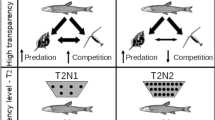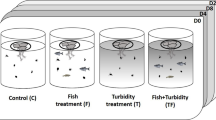Summary
Growth and reproduction of twoDaphnia species (Cladocera) from Lake Constance were measured experimentally in a through-flow laboratory system under different food conditions, in order to investigate the effect of food quality on zooplankton populations. The cryptomonadRhodomonas sp. and the diatomStephanodiscus hantzschii were used as food. BothDaphnia species grew well at concentrations of 0.2–2.0 mgC/l ofRhodomonas sp., and 0.4–2.0 mgC/l ofS. hantzschii, whileStephanodiscus concentrations of 0.2 mgC/l did not supportDaphnia growth. Nitrogen content, which was very different in the two algae (C/N ratio = 4.9 forRhodomonas and 10.9 forS. hantzschii), was presumed to be the limiting factor. To test this hypothesis, nitrogen-limitedRhodomonas was offered to the cladocerans and their growth observed: the reduction in algal nitrogen content hindered animals' growth and reproduction. Results suggested that zooplankton production may also be affected by the chemical composition of the food algae, and that nitrogen potentially limits production, even in freshwater environments that are generally not N-limited.
Similar content being viewed by others
References
Ahlgren G, Lundstedt L, Brett M, Forsberg C (1990) Lipid composition and food quality of some freshwater phytoplankton for cladoceran zooplankters. J Plankt Res 12:809–818
Arnold DE (1971) Ingestion, assimilation, survival and reproduction byDaphnia pulex fed seven species of blue-green algae. Limnol Oceanogr 16(6):906–920
Blažka P (1966) Metabolism of natural and cultured populations ofDaphnia related to secondary production. Verh Int Ver Limnol 16:380–385
Bogdan KG, Gilbert JJ (1987) Quantitative comparison of food niches in some freshwater zooplankton. A multi-tracer cell approach. Oecologia 72:331–340
Cahoon LB (1981) Reproductive response ofAcartia tensa to variations in food ration and quality. Deep-Sea Res 28 A(10): 1215–1221
Checkley DM Jr (1980) The egg production of a marine planktonic copepod in relation to its food supply: Laboratory studies. Limnol Oceanogr 25(3):430–466
Checkley DM Jr (1985) Nitrogen limitation of zooplankton production and its effect on the marine nitrogen cycle. Arch Hydrobiol Beih 21:103–114
De Mott WR (1986) The role of taste in food selection by freshwater zooplankton. Oecologia 69:334–340
Dortch Q, Clayton JR Jr, Thoresen SS, Cleveland JS, Bressler SL, Ahmed SI (1985) Nitrogen storage and use of biochemical indices to assess nitrogen deficiency and growth rate in natural plankton populations. J Mar Res 43:437–464
Droop MR (1973) Some thoughts on nutrient limitation in algae. J Phycol 9:264–272
Fogg GE (1959) Nitrogen nutrition and metabolic patterns in algae. Symp Soc Exp Biol 13:106–125
Forsyth DJ, James MR (1990) Effect of food type and concentration on production of faecal pellets byBoeckella propinqua. Arch Hydrobiol 119(2):183–190
Geller W (1984) A device for the in situ measurement of zooplankton food selection, grazing and respiration rates. Verh Int Ver Limnol 22:1425–1431
Geller W, Müller H (1981) The filtration apparatus ofCladocera: filter mesh sizes and their implications on food selectivity. Oecologia 49:316–321
Geller W, Müller H (1985) Seasonal variability in the relationship between body length and individual dry weight as related to food abundance and clutch size in two coexistingDaphnia species. J Plankt Res 7(1):1–18
Giani A (1990) The nutritive value of different algae as food for twoDaphnia species. Verh Int Ver Limnol 24:(in press)
Gilbert JJ, Bogdan KG (1981) Selectivity ofPolyarthra andKeratella for flagellate and aflagellate cells. Verh Int Ver Limnol 21:1515–1521
Gliwicz ZM (1990) Food thresholds and bodysize in cladocerans. Nature 343:638–640
Guillard RR, Lorenzen CJ (1972) Yellow-green algae with chlorophyllide C1,2. J Phycol 8:10–14
Hallam TG, Lassiter RR, Li J, Suarez LA (1990) Modelling individuals employing an integrated energy response: applications toDaphnia. Ecology 71:938–954
Herbert D, Phipps PJ, Strange PA (1971) Chemical analysis of microbiol cells. In: Norris JR, Ribbons DW (eds) Methods in microbiology, Vol. 58. Academic Press, London, pp 209–344
Houde SEL, Roman MR (1987) Effects of food quality on the functional ingestion response of the copepodAcartia tonsa. Mar Ecol Prog Ser 40:69–77
Infante A, Litt AH (1985) Differences between two species ofDaphnia in the use of 10 species of algae in Lake Washington. Limnol Oceanogr 30(5):1053–1059
Itzhaki RF, Gill DM (1964) A micro-biuret method for estimating proteins. Analyt Biochem 9:401–410
Kilham SS (1978) Nutrient kinetics of freshwater planktonic algae using batch and semicontinous methods. Mitt Int Ver Limnol 21:147–157
Kiorboe T (1989) Phytoplankton growth rate and nitrogen content: implications for feeding and fecundity in a herbivorous copepod. Mar Ecol Prog Ser 55:229–234
Klaveness D (1988) Ecology of theCryptomonadida: a first review. In: Sandgreen CD (ed) Growth and reproductive strategies of freshwater phytoplankton. Cambridge University Press, Cambridge, pp 105–133
Knisely K, Geller W (1986) Selective feeding of four zooplankton species on natural lake phytoplankton. Oecologia 69:86–94
Kohl JG, Micklisch A (1988) Ökophysiologie der Algen. Wachstum und Ressourcenutzung. Gustav Fischer Verlag, Stuttgart
Lampert W (1976) A directly coupled, artificial two step food chain for long-term experiments with filter-feeders at constant food concentration. Mar Biol 37:349–355
Lampert W (1977) Studies on the carbon balance ofDaphnia pulex as related to environmental conditions. II. The dependence of carbon assimilition on animal size, temperature, food concentration and diet species. Arch Hydrobiol Suppl 48:310–335
Lampert W (1978) A field study on the dependence of the fecundity ofDaphnia spec. on food concentration. Oecologia 36:363–369
Lampert W (1981) Inhibitory and toxic effects of blue-green algae onDaphnia. Int Rev Gesamten Hydrobiol 66:285–298
Matveev VF, Balseiro EG (1990) Contrasting responses of two cladocerans to changes in the nutritional value of nannoplankton. Freshw Biol 23:197–204
May L (1987) Culturing freshwater, planktonic rotifers onRhodomonas minuta varnannoplanctonica Skuja andStichococcus bacillaris Nägeli. J Plankt Res 9(6):1217–1223
Mohammed AA, Muller H (1981) Zur Nährstofflimitierung des Phytoplanktons im Bodensee. Arch Hydrobiol Suppl 59:151–191
Pejler B (1977) Experience with cultures based onRhodomonas. Arch Hydrobiol Beih 8:264–266
Porter KG (1973) Selective grazing and differential digestion of algae by zooplankton. Nature 244:179–180
Porter KG (1977) The plant-animal interface in freshwater ecosystems. Am Sci 65:159–170
Porter KG, Feig YS (1980) The use of DAPI for identifying and counting aquatic microflora. Limnol Oceanogr 25(5): 943–948
Porter KG, Orcutt JD Jr (1980) Nutritional adequacy, manageability and toxicity as factors that determine the food quality of green and blue-green algae forDaphnia. Am Soc Limnol Oceanogr Spec Symp 3:268–281
Rivkin RB (1989) Influence of irradiance and spectral quality on the carbon metabolism of phytoplankton. I. Photosynthesis, chemical composition and growth. Mar Ecol Prog Ser 55:291–304
Rothhaupt KO (1990) Differences in particle size-dependent feeding efficiencies of closely related rotifer species. Limnol Oceanogr 35(1):16–23
Rott E (1981) Some results from phytoplankton counting intercalibrations. Schweiz Z Hydrol 43:34–62
Schwartz SS, Ballinger RE (1980) Variations in life history characteristics ofDaphnia pulex fed different algal species. Oecologia 44:181–184
Sick LV (1976) Nutritional effect of five species of marine algae on the growth, development, and survival of the Brine shrimpArtemia salina. Mar Biol 35:69–78
Skogstad A, Granskog L, Klaveness D (1987) Growth of freshwater ciliates offered planktonic algae as food. J Plank Res 9:503–512
Sokal RR, Rohlf J (1981) Biometry. WH Freeman and Company, San Francisco
Sommer U (1987) Factors controlling the seasonal variation in phytoplankton species composition. — A case study for a deep, nutrient rich lake. Progr Phycol Res 5:110–173
Sommer U (1989) Nutrient status and nutrient competition of phytoplankton in a shallow, hypertrophic lake. Limnol Oceanogr 34(7):1162–1173
Sommer U, Gliwicz ZM, Lampert W, Duncan A (1986) The PEG-model of seasonal succession of planktonic events in fresh waters. Arch Hydrobiol 106(4):433–471
Spoehr HA, Milner HW (1949) The chemical composition ofChlorella: effect of environmental conditions. Plant Physiol 24:120–149
Stemberger RS, Gilbert JJ (1985) Body size, food concentration and population growth in planktonic rotifers. Ecology 66(4):1151–1159
Sterner RW (1989) The role of grazers in phytoplankton succession In: Sommer (ed) Plankton Ecology. Succession in plankton communities. Springer Verlag, Berlin, pp 107–170
Taylor BE (1985) Effects of food limitation on growth and reproduction ofDaphnia. Arch Hydrobiol Beih 21:285–296
Threlkeld ST (1979) The midsummer dynamics of twoDaphnia species in Wintergreen Lake, Michigan. Ecology 60:165–179
Tilman D (1977) Resource competition between planktonic algae: an experimental and theoretical approach. Ecology 58:338–348
Tilman D, Kilham SS, Kilham P (1982) Phytoplankton community ecology: the role of limiting nutrients. Ann Rev Ecol Syst 13:349–372
Vaughan DS, Kanciruk P (1982) An empirical comparison of estimation procedures for the von Bertalanffy growth equation. J Cons Int Explor Mer 40:211–219
Verdouw H, Dekkers EMJ (1982) Nitrogen cycle of Lake Vechten: concentration patterns and internal mass-balance. Hydrobiologia 95:191–197
Vijverberg J (1990) Culture techniques for studies on the growth, development and reproduction of copepods and cladocerans under laboratory and in situ conditions: a review. Freshw Biol 21:317–373
Viner AB, White E (1987) Lake plankton processes. Phytoplankton growth. In: Viner, AB (ed) Inland waters of New Zealand. DSIR Bulletin 241, Wellington, pp 191–223
ZöllerN, Kirsch K (1962) Über die quantitative Bestimmung von Lipiden (Mikromethode) mittels der vielen natürlichen Lipoiden (allen bekannten Plasmalipiden) gemeinsamen Sulphophosphovanillin-Reaktion. Z Ges Exp Med 135:545–561
Author information
Authors and Affiliations
Rights and permissions
About this article
Cite this article
Giani, A. Implications of phytoplankton chemical composition for zooplankton production: experimental evidence. Oecologia 87, 409–416 (1991). https://doi.org/10.1007/BF00634599
Received:
Accepted:
Issue Date:
DOI: https://doi.org/10.1007/BF00634599




